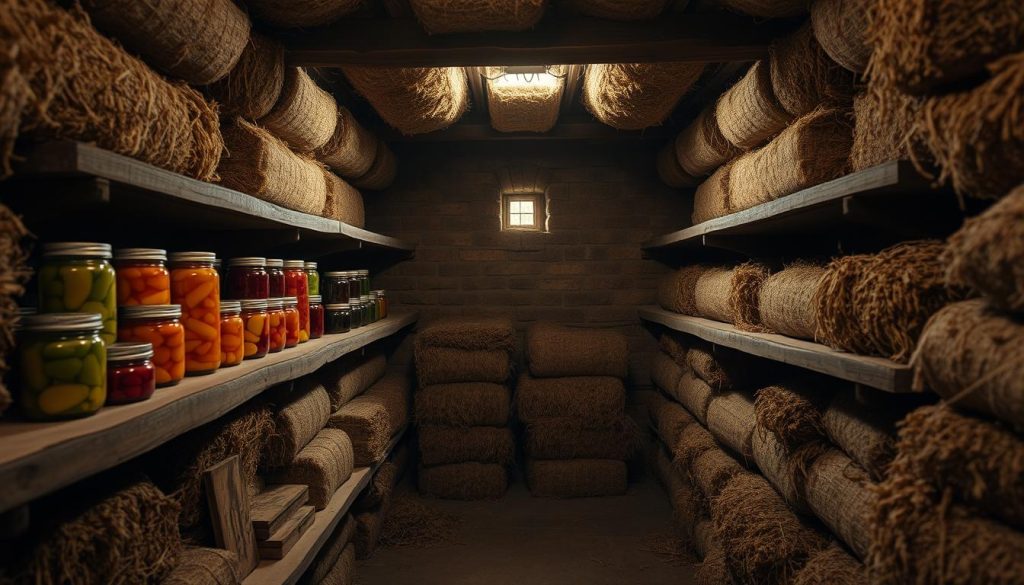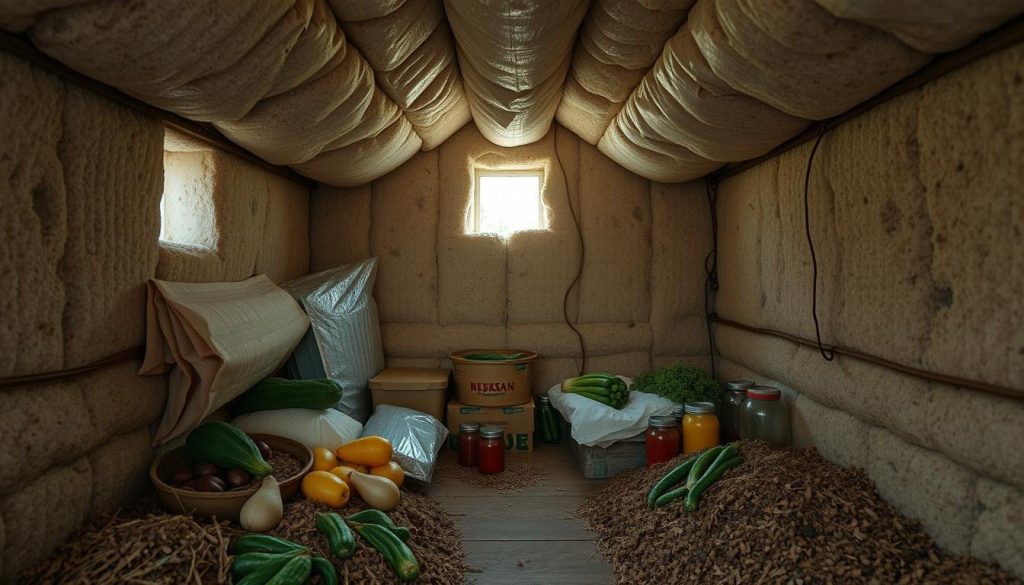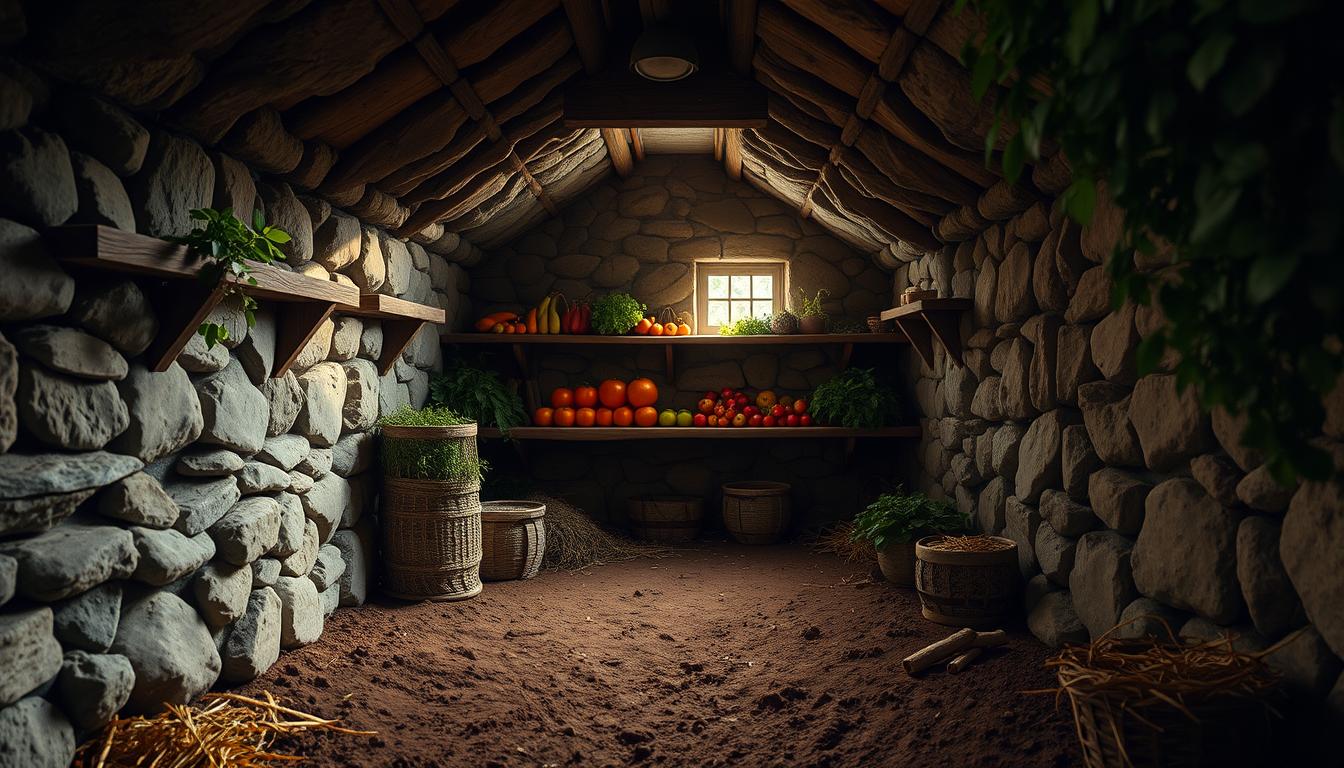Building a good root cellar design is key to keeping food fresh. It’s all about the right temperature control and humidity levels. Good insulation helps keep your storage area stable, making your food last longer.
Insulating your root cellar does more than just keep food fresh. It also saves energy and money. Let’s explore the basics of insulation and how it boosts your food storage game.
Understanding the Importance of Insulation
Insulating a root cellar is key to keeping food fresh. It helps control the climate inside, saving energy and cutting costs.
What Is a Root Cellar?
A root cellar is a place to store fruits and veggies. It uses the earth’s cooling to keep food fresh. Today, building a root cellar is still smart because of its benefits.
Benefits of Insulating Your Root Cellar
Insulation is crucial in building a root cellar. It creates a stable climate. This keeps your food from freezing in winter or spoiling in summer.
Insulation brings many benefits:
- It keeps food quality high by maintaining the right temperature and humidity.
- It saves energy, which means lower bills.
- It’s cost-effective because it reduces the need for extra climate control.
Types of Insulation Materials
Choosing the right insulation for your root cellar is key. I’ll talk about foam board, fiberglass, and mineral wool. Each has its own benefits and how you install them matters a lot.
Foam Board Insulation
Foam board insulation is a top pick because it’s easy to use and works well. It’s a solid panel that stops heat from moving around. It also keeps moisture out, which is good for keeping your cellar’s humidity steady.
When you put it in, make sure to seal all edges and gaps. This helps it work better as a thermal barrier.
Fiberglass Insulation
Fiberglass is cheap and easy to find. It’s made of glass fibers that trap air, keeping things warm or cool. It comes in batts or rolls, making it simple to install.
To get the most out of it, fit the batts tightly between studs. Seal any gaps to stop air from getting through. This keeps your cellar’s temperature steady.
Mineral Wool Options
Mineral wool is made from natural rock or recycled steel. It’s great for soundproofing and fire safety. It also keeps your cellar warm in winter and cool in summer.
You can install it like fiberglass, using batts or loose-fill. It might cost more, but it’s durable and works well, making it a good choice for your cellar.
Insulation Techniques for Root Cellars
Proper insulation in your root cellar is key for the best storage conditions. We’ll explore how to insulate walls, ceilings, and floors. This ensures energy retention and the right barrier placement.
Adding Insulation to Walls
Start with wall insulation for the best energy retention. Use foam board or fiberglass, sealing all gaps. Installing vapor barriers is crucial to prevent moisture and keep temperatures stable.
Ceiling Insulation Strategies
Ceiling insulation stops heat loss. Add insulation blankets or spray foam to the ceiling for a tight fit. Make sure to place barriers correctly to avoid air leaks.
Floor Insulation Considerations
Floor insulation boosts your root cellar’s thermal efficiency. Use rigid foam or cork boards under the floor. This enhances energy retention. Proper placement is key to block cold air from the ground.
How to Calculate Insulation Needs
Calculating insulation needs for your root cellar involves a space assessment and knowing about R-value. Let’s explore how to ensure your insulation is right for your storage needs.
Assessing Your Space Size
Start by measuring your root cellar’s dimensions. This includes height, width, and length. These measurements help figure out how much insulation you’ll need.
With these numbers, you can estimate the insulation material needed. Accurate measurements are key. They affect how well your insulation works. Keeping temperatures stable is important for your stored food.
R-Value Importance
R-value shows how well insulation blocks heat. The higher the R-value, the better it insulates. Choosing the right R-value depends on your local climate and root cellar needs.
For underground storage, colder areas need higher R-values. This ensures your food stays at a consistent temperature. This is vital for keeping food fresh.
In short, a detailed space assessment and understanding R-value are crucial. They help you find the perfect insulation thickness for your root cellar. This ensures your food stays fresh for longer.
Ventilation in Insulated Root Cellars
Insulating your root cellar is key to keeping a stable temperature. But, it’s also vital to have good air circulation. This prevents mold and keeps your food fresh. Finding the right balance between insulation and ventilation is crucial.
Balancing Insulation and Airflow
Getting the airflow right is as important as insulation for humidity control. A well-insulated cellar can hold too much moisture. This can cause mold and mildew. Ventilation helps manage both temperature and humidity.
Types of Ventilation Systems
There are many ways to ventilate your insulated root cellar:
- Natural Ventilation: This uses vents at different heights for passive air flow. It helps control humidity without mechanical help.
- Mechanical Ventilation: Fans or blowers ensure air moves consistently. This is great for bigger cellars.
- Hybrid Systems: Mixing natural and mechanical ventilation is the best choice. It offers good air flow and saves energy.
Each system is important for the right climate in your root cellar. It keeps your food fresh and prevents spoilage.
Climate Considerations

When insulating your root cellar, knowing about climate adaptation is key. The type of insulation needed changes a lot based on weather and where you live. Tailoring your insulation strategies can really help.
Insulation for Different Weather Conditions
Seasonal insulation is crucial for different weather patterns. In cold places, you need thick insulation to keep things from freezing. But in warm areas, you need insulation that also lets in air to stay cool.
Regional Recommendations
Insulation strategies vary by region. In cold areas, foam board insulation works well because it keeps heat out. In warm, humid places, mineral wool is better because it resists moisture and insulates well.
Using these specific methods helps your root cellar stay effective all year, no matter the local weather.
Common Insulation Mistakes to Avoid
Insulating your root cellar right is key. Avoiding common mistakes ensures it works well and lasts long. Mistakes can ruin your storage space and mess with moisture levels.
Over-Insulation Issues
Too much insulation is a big mistake. It might seem like more is better, but it’s not. Too much can cause bad air and waste energy. You want the right amount that lets your cellar breathe.
Moisture Trapping Problems
Managing moisture is crucial in your root cellar. Wrong insulation can trap moisture, causing mold and damage. Use barriers and good ventilation to keep moisture out. This stops condensation and keeps your cellar dry.
DIY Insulation Projects for Root Cellars

Starting a DIY insulation project for your root cellar is rewarding. It saves money and lets you know your storage conditions well. Here’s a detailed guide, including the tools and steps to keep your root cellar insulated all year.
Tools You’ll Need
- Measuring tape
- Utility knife
- Staple gun
- Insulation material (foam board, fiberglass, or mineral wool)
- Protective gloves and eyewear
- Adhesive for insulation
- Caulking gun and sealant
- Safety mask
Having the right tools is key for a successful DIY insulation project. Make sure you have everything before you start to avoid delays.
Step-by-Step Guide to Insulating
- Measure Your Space: Use a measuring tape to get your root cellar’s exact dimensions. This will tell you how much insulation you need.
- Choose Your Insulation Material: Pick foam board, fiberglass, or mineral wool based on your needs.
- Prepare the Area: Clean the walls, ceiling, and floor of your root cellar. Make sure they’re dust-free and clear of debris.
- Cut the Insulation: Cut the insulation material with a utility knife. Always wear gloves and a safety mask.
- Attach Insulation: Use adhesive for foam boards. For fiberglass or mineral wool, staple them to the frame.
- Seal Gaps: Use a caulking gun and sealant to fill gaps and cracks. This stops air leaks.
- Inspect Your Work: Check every corner after installation. Make sure there are no gaps and the insulation is secure.
By following this guide, you’ll effectively insulate your root cellar. This keeps your produce fresh and boosts your home’s energy efficiency.
Hiring a Professional for Insulation
Thinking about insulation for your root cellar? Sometimes, it’s better to hire pros instead of doing it yourself. Professionals have the skills and tools needed for effective insulation.
When to Consider Professional Help
There are times when you really need professional insulation services:
- Complex Projects: If your root cellar is shaped or sized in a way that makes insulation tricky.
- Material Expertise: Knowing the best insulation material for your area might need an expert’s advice.
- Time Constraints: If you’re short on time for a DIY project.
- Quality Assurance: Pros can make sure insulation is done right, avoiding future problems.
Finding the Right Contractor
Finding the right contractor is key for a good insulation job. Here’s how to pick:
- Research: Look up local contractors and check out their reviews on Yelp and Google Reviews.
- Get Multiple Quotes: Ask different contractors for their prices and what they offer.
- Check Credentials: Make sure they’re licensed and insured. Checking with local trade groups can help.
- Ask for References: Talk to past clients to see if the contractor is reliable and does good work.
- Detailed Contract: Get a written contract that outlines the job, materials, and timeline.
By choosing professional help and picking the right contractor, your root cellar insulation will last and work well.
Maintenance of Insulation

Keeping your root cellar insulation in top shape is key. Regular checks and a maintenance plan help keep your storage perfect. Let’s talk about how to keep your insulation in great condition.
Regular Checks and Repairs
I check my insulation often to catch any problems early. I look for wear, moisture damage, or gaps. Fixing these small issues can save a lot of money and time.
Small repairs, like fixing gaps or replacing damaged parts, make a big difference. Having a handy toolkit for these preventive maintenance tasks is very useful. It helps stop small problems from becoming big ones.
How to Maintain Optimal Conditions
Keeping your root cellar environment steady is important. Check the temperature and humidity often. Use tools like hygrometers and thermometers to keep things right.
I also watch for mold or mildew, which can harm insulation. A good cleaning schedule helps keep the cellar clean and dry. This stops mold and mildew problems.
Being proactive with insulation upkeep ensures your root cellar works well for years. Regular preventive maintenance avoids expensive fixes and keeps your food fresh. This makes your root cellar a reliable place for storing food all year.
Additional Tips for Effective Root Cellar Storage
Getting your root cellar to work its best can really help keep your food fresh longer. It’s not just about keeping it warm or cool. You also need to know how to store things and organize your space well. Let’s look at some key tips for better storage and organization.
Best Practices for Storing Vegetables
Knowing how to store different veggies is key to keeping them fresh. Hard veggies like carrots and beets do well in damp sand to keep moisture in. On the other hand, potatoes need a dark, cool, and dry spot, best in breathable bags to stop them from sprouting.
It’s also smart to keep fruits that give off ethylene gas away from veggies that don’t like it. This helps keep your veggies fresh longer. By using these specific storage methods, you can make sure each veggie gets the best conditions for keeping fresh.
Utilizing Space Efficiently
To make the most of your root cellar’s space, you need to organize well. Set up shelves and bins to let air flow and make it easy to reach things. Use the vertical space by stacking crates or installing tiered shelves, with heavier items at the bottom.
Rotating your stored items regularly is also a good idea. Move older produce to the front to avoid it going bad. These strategies not only save space but also help keep your insulation working right. This keeps the temperature and humidity in your cellar just right.

